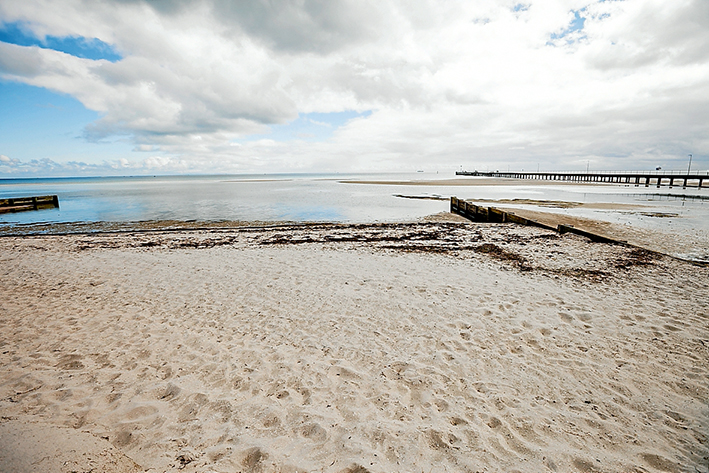
THE new section of Rosebud pier, officially opened two weeks ago with little fanfare by Parks Victoria, complements nearby beach renourishment completed at about the same time by the Department of Environment, Land, Water and Planning.
Parks has spent about $3.5 million on the 329-metre long pier in two tranches between 2009 and this year, while the state environment department has spent about $500,000 in two lots to replenish the beach.
The first attempt was in mid-2009 when contractors built a sandbag wall on the eroded shoreline and placed imported sand between it and the water.
The sand disappeared in April 2009 when storms and high tides blasted the beach as well as others around Port Phillip. The sandbag wall, or revetment, survived the battering.
The vandal-proof revetment consists of six levels, three below low tide and three above, and is designed to last 15 years.
The project cost $250,000 in 2009 and the department claimed it would create a beach 160 metres long by 10 metres wide. It did but nature took it away.
This time environment department contractors have placed 5000 tonnes of sand on the beach and built three groynes designed to keep sand in place. One groyne is right next to the pier on the eastern side and two stretch into the water from the “new” beach.
About 3000 cubic metres of sand came from excavation of the Banksia Point multi-storey development on the beach side of Point Nepean Rd and Jetty Rd (opposite the pizza shop) and 2000 cubic metres is from a sand spit west of the stormwater drains at the western end of the beach.
The fresh sand has created a beach 170 metres long and 15 metres wide, and covers most of the sandbag wall as well as rocks and rubble from foreshore filling work done in the 1970s, which had been exposed.
The beach work is connected to shire plans – known as “Project Rosebud” – to spend $2.25 million on the Jetty Rd foreshore precinct including a proposed boardwalk on top of the sandbags and stormwater pipes.
In April, Len Warfe of Port Phillip Conservation Council said there was ample evidence that groynes interrupted natural coastal processes. “An excellent example is at the site in question – the stormwater pipes act as a groyne, trapping sand to the west and depleting sand to the east where the sandbag wall was built in 2009. Similar examples of groynes failing to perform as beach stabilisers exist around Port Phillip.”
Earlier that month, shire coastal planner Neil Daykin told councillors the sandbag wall was built to limit the erosion of the fill area as well as dispersal of rubble material.
It had been suggested the sandbag wall and fill should be removed to restore the beach to its natural state but this could cost $400,000 or more.
“This cost would vary significantly if the fill material is found to be contaminated or unsuitable for alternative uses,” he told councillors.
Mr Daykin was quoting from a report prepared late last year by Alex Atkins, former director of infrastructure: “It may be noted that there appear to have been two eras of filling of the foreshore in proximity to the Rosebud pier – one with relatively clean fill from the construction of Mornington Peninsula Freeway and one associated with a sewerage installation program, which appears to be the source of the rubble material that continues to be a problem.”
Earlier this year the shire received two petitions from residents – one calling for the removal of the sandbag wall and fill (signed by 76 people) and one calling for the opposite (131 signatures).
The shire council backed the environment department plan to keep the sandbags and replenish the beach.
Proposed shire works to come include a new play area, “public plaza and waterfront deck”, promenade, paths, fitness stations, sprint track, and “event servicing place”.
Foreshore “protector” Jenny Warfe, who lead opposition to the Port of Melbourne’s Channel Deepening Project of 2008-09, says the shire’s plan for the precinct is “another giant waste of ratepayers’ money”.
She said it made no sense to build “hard infrastructure in an area where, to get lasting solutions, nature needs to be restored”.
“The reason there is no beach is because the natural beach is buried under 55,000 cubic metres of fill dumped there in the 1970s from the freeway and trunk sewer construction.”
First published in the Southern Peninsula News – 22 September 2015


